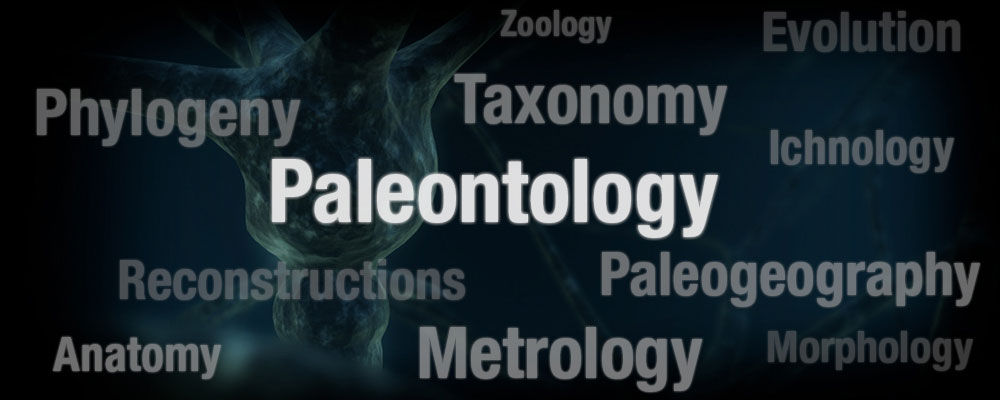
Publications > Dinogeography
- Bruhathkayosaurus body mass
- Dinosaur densities press release
- Tetrapod body densities
- Sauropod Encyclopedia
- Palaeoloxodon skull evolution
- Palaeoloxodon poster
- Theropod Encyclopedia
- P. antiquus from Germany
- The Body Size of Proboscideans
- Siculo-Maltese dwarf elephants
- Songhua River Mammoths
- Dinogeography
Author: Rubén Molina
It is interesting to know that the current biogeographic classification, which separates in large terrestrial ecozones distribution of fauna, had a significant influence in the studies made by Sclater, ornithologist, in 1858 on birds, the current dinosaurs. Thus begins a antecedent that influenced in the work of Wallace, who in 1876 separated the world in large land areas where wildlife is distributed today.
This particularly concerns us, because we are conducting a study on the distribution of dinosaurs through the different eras and geographical areas of the Mesozoic. It can serve as a basis for reviewing the faunal replacements, the dispersion of the various groups over time, the links between two or more taxa, convergent adaptations that arose by geographical isolation and some aspects of the anatomy of these animals.
Looking at the current ecozones, we can clearly see that there is a separation marked by the Ecuador line that separates the earth into two hemispheres, north and south. Other factors influence the separation of continents, such as deserts, poles, high mountains or mountain ranges that act as barriers to terrestrial migration.
Recent
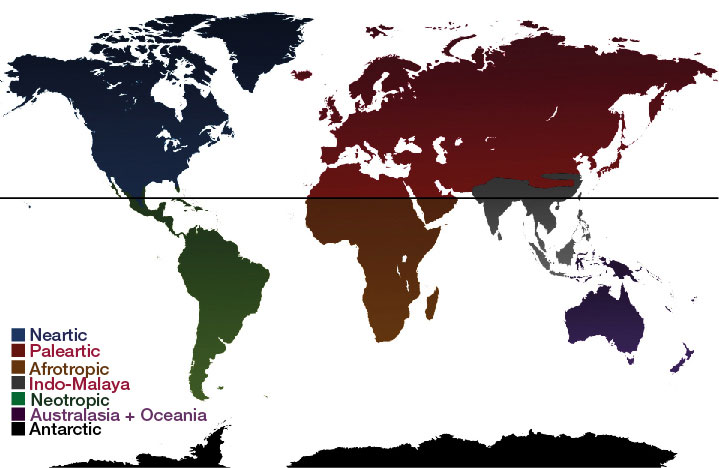
The most complicated problem to interpret the dispersion of the dinosaurs, is that the fossil record fails to provide sufficient information to have a certainty of the total presence of groups that existed contemporaneously and local. Anyway we have enough material to draw an idea of how this migration was occurring over time and find a material that can resolve some issues on the evolution of dinosaurs, such as those mentioned above.
Here we present the first hypothetical distribution of what might be the result of major ecozones in the temporal subdivisions of the Mesozoic, depending on the separation or union of continents or in the effect of hemispheric areas. Dinosaur groups have been divided into taxa at the family level, subfamily or clades with a very close phylogenetic similarity. The maps and data are quite preliminary so this study will change in the time.
We use the line of Ecuador as a posible strong influencing factor apart from the connections between continents, but we should consider that during the Mesozoic climates were more uniform than at present,.
The arrows indicate when species were exchanged between two continents, the numbers, the similarity between taxa as that resulted from our first database. Several Tables will be made to present the same division method used.
Early Triassic
During the Triassic only some footprints are known from northern Pangea, in the area that is now Poland. According to studies by Sun et al, 2012 can be considered that there was n’t any Dinosauromorpha in the shouth of that pediod.
Middle Triassic
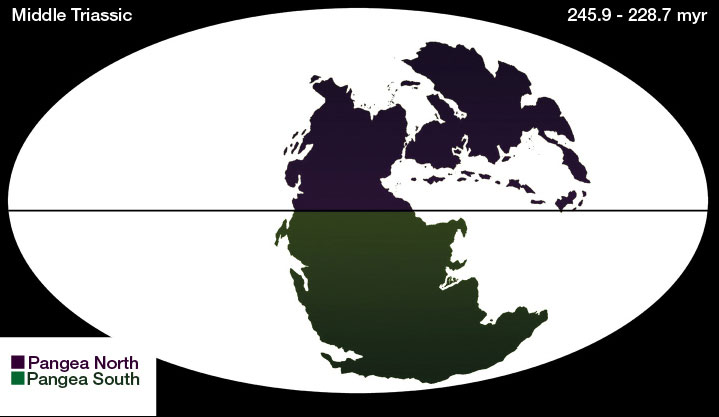
At this time only a few traces are known, few doubtful specimens in northern Pangea and a small number of species in southern Pangea, so the information is insufficient.
Late Triassic

Here in the northern eastern Pangea (Asia) there is a very poor dinosaur fossil record, however by few known remains we know that they had been very advanced and similar to the rest of Pangea.
Early Jurassic
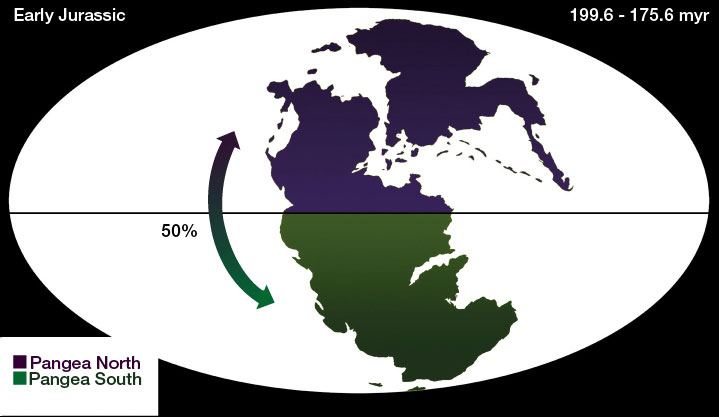
At first there was a significant extinction of several families, so their ecological areas were covered by other taxa, while at the end of this period followed by another important replacement of the dominant fauna.
Middle Jurassic
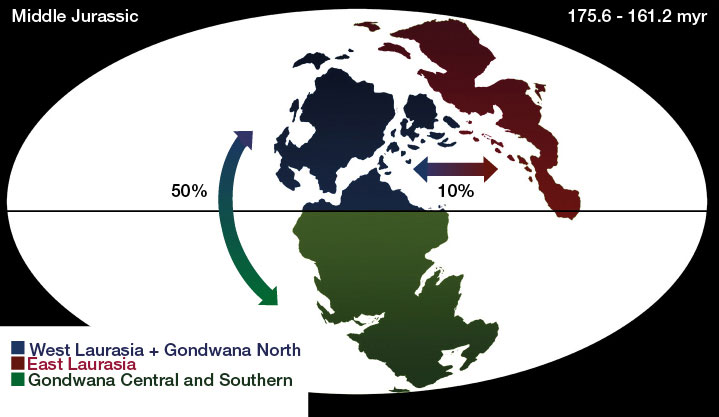
Start the independence of the eastern Laurasia, in consequence is notorius the absence and presence of different families of dinosaurs that evolve in parallel in similar niches, so their relationship among taxa is as expected, more different than between Laurasia West and Gondwana.
Late Jurassic
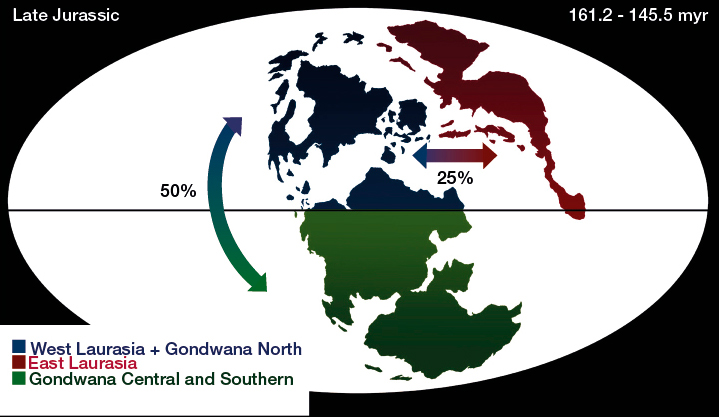
During the Late Jurassic there is a similar situation to the Middle Jurassic, however West Laurasia began to distance from Gondwana.
Early Cretaceous
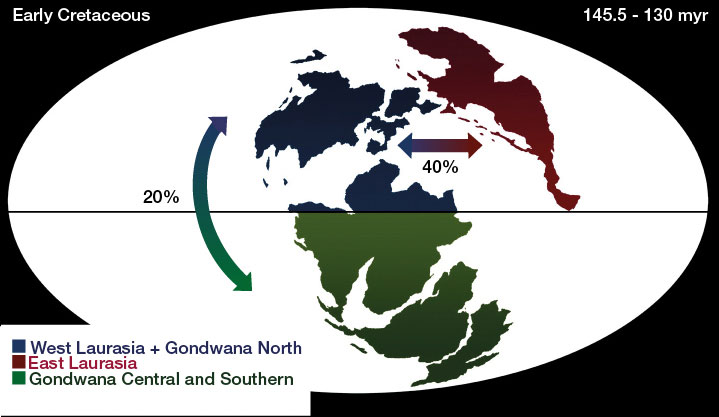
This period is key in the diversification of dinosaurs in the next million years, because it shows a dispersion of several groups of dinosaurs between north and south, including eastern Laurasia (Asia) and in current times is becoming more harder between the two hemispheres.
Early Middle Cretaceous
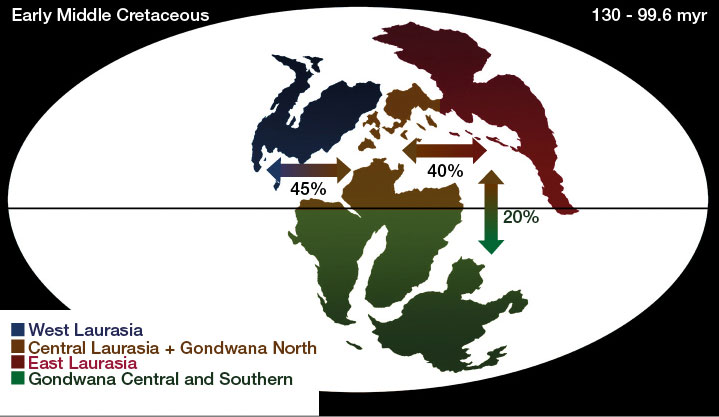
The western Laurasia (North America) has a shrinking contact with the outside world while Central Laurasia (Europe) becomes a link between Laurasia East (Asia) and Gondwana maintaining mixed fauna until the end of the Mesozoic.
Early Late Cretaceous
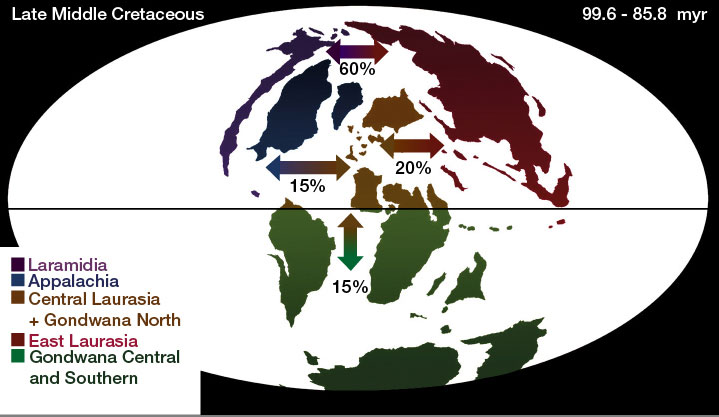
The continents are fragmented like never before, West Laurasia is divided into two parts: Appalachia and Laramidia, latter one would have more influence in the interchange with Eastern Laurasia (Asia). Gondwana retains a similar population by its early separation.
Late Cretaceous
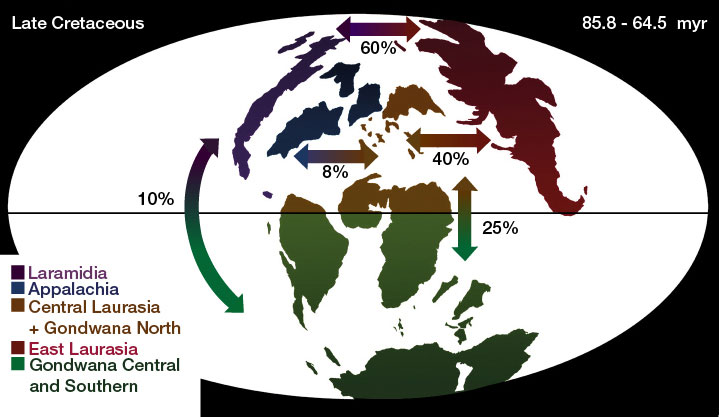
Laramidia and Asia have a strong similarity not only between families but between genders. Unfortunately remains in Africa are very little known, so we do not know if it would maintain a fauna similar to that of the rest of Gondwana or Europe. South America has several indigenous forms possibly shared with other southern areas like Antarctica, Hindustan, Australia or Madagascar, in return the similarities would be more for conservation of taxa through time.
References:
Ali & Krause, 2011. Late Cretaceous bioconnections between Indo-Madagascar and Antarctica: refutation of the Gunnerus Ridge causeway hypothesis. Journal of Biogeography (J. Biogeogr.) (2011) 38, 1855–1872
Brusatte, Niedźwiedzki & Butler, 2010. “Footprints pull origin and diversification of dinosaur stem lineage deep into Early Triassic”. Proceedings of the Royal Society B 278 (1708): 1107–1113.
Ford, Tracy,2012 http://www.paleofile.com/
Llorente & Morrone (eds.). 2001. Introducción a la biogeografía en América Latina: Teorías, conceptos, métodos y aplicaciones. Las Prensas de Ciencias, Facultad de Ciencias. UNAM. México, D.F. 277 p.
Ptasynski, 2000. “Lower Triassic vertebrate footprints from Wiory, Holy Cross Mountains, Poland” . Acta Palaeontologica Polonica. 45 (2): 151–194.
Sclater 1858. On the general geographical distribution of the members of the class Aves. J. Proc. Linnean Soc. Zool. 2 130–145.
Sun, Joachimski, Wignall, Yan, Chen, Jiang, Wang & Lai, 2012. Lethally Hot Temperatures During the Early Triassic Greenhouse. Science, 338 (6105): 366-370
Tweet, Justin http://www.thescelosaurus.com/
Wallace 1876. The Geographical Distribution of Animals.
Weishampel, Dodson, & Osmólska (eds.), The Dinosauria (2nd edition). Univerity of California Press, Berkeley 413-437





